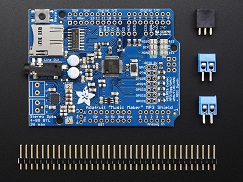Devices |
The following Micro Controllers, Sound Generators, Amplifiers and Sensors are used in the projects and devices found on this web site. |
| Device | Description |
|---|---|
 |
Arduino Uno Micro Controller This is the main electronic device (with it's variants) that is used as a standalone MIDI controller for the majority of the projects displayed on this web site. An Arduino is an open-source electronics platform based on easy-to-use hardware and software. It's intended for anyone making interactive projects. Arduino senses the environment by receiving inputs from many sensors, and affects its surroundings by controlling lights, motors, and other actuators A "Genuine" device cost around £20, but an open source clone can be had for around £5.00 if you are in the habit of making blue smoke with them. |
 |
Bare Conductive Touch Board This combines a version of an Arduino with a 12 electrode input capacitive sensor and an Audio CODEC than can play MIDI, MP3, WAV and Ogg Vorbis files. Therefore it is very versatile device though at £60 plus pound fairly expensive. |
| N.B. "Shields" are small circuit boards that piggy-back onto the top of Arduino Uno and Mega boards and their equivalent clones. They add extra functionality such as playing audio files. Other shields can also provide onboard data logging, GPS, environmental sensing and much more. |
| Device | Description |
 |
Music Instrument Shield (Sparkfun) The SparkFun Musical Instrument Shield is an easy way to add great sounding MIDI sound to your next Arduino project. This board is built around the VS1053 MP3 and MIDI codec IC, wired in MIDI mode. Simply connect a speaker/stereo/pair of headphones to the 1/8" stereo jack on the shied and pass the proper serial commands to the IC and you'll be playing music in no time! The VS1053 contains two large tone banks including various piano, woodwinds, brass, synth, SFX and percussion sounds. The shield is also capable of playing several tones simultaneously (maximum polyphony of up to 31 sounds). They cost around £24.00 |
 |
Adafruit Audio FX Mini Sound Board WAV/OGG Trigger 16MB Flash The Audio FX Mini sound board is a simple to use, low cost audio effects trigger that does not require any programming. It does not need an Arduino+Shield Features:
For reference, trigger options are as follows:-
|
 |
MP3 Player Arduino Shield
|
 |
Adafruit Music shield It will play a range of music formats. The files are placed on a micro SD card. It has the added advantage of a built in 3W class D stereo amplifier. |
Amplifiers
These amplify the low powered "line" signal from shields and circuit boards.| Device | Description |
|---|---|
 |
Audio Amplifier Generic Class D Stereo Amplifier. It runs happily on 9v and is surprisingly loud. Used in about 50% of my projects. They cost around £3.00. This one has the advantage of small size, volume control and can run off 6-15v. It is worth checking that the voltage range fits in with the other components used (I have been caught out this way a couple of times). |
 |
Class D stereo Amplifier, 3 Watt. N.B. Class D means it amplifiers digitally, sending pulses to a speaker. The speaker acts a s low pass filter converting the signal to analogue. THe digital nature of the's amps can make "hissy". In addition, quick changes in sound level can cause glitches which can disrupt the Arduino if they share the same battery supply. |
Sensors
| Device | Description |
|---|---|
 |
Ultrasonic Range Finders These can detect how far away and object is (from a few centimetres up to 3 or 4 metres). Detecting distances of (say) 10, 20, 30, centimetres can form the basis of either an air guitar or an air drum. See the Air-Drum-Flute-Guitar.These devices can be had for around £1.00. More expensive versions (£24+) have additional components to compensate for changes in air temperature and humidity. |
 |
Infra Red (IR) range finder. These detect infrared light reflected back from another surface and give an estimate of distance, typically within 10cm to a metre. |
 |
Sparkfun "Nine Degrees of Fredom", it has a 3-Axis Gyroscope with four selectable ranges, 3-Axis Accelerometer, again with four selectable ranges, and 3-axis magnetometer. SparkFun 9DoF IMU Breakout - ICM-20948 (Qwiic)
|
 |
Infra Red (IR) receiver These can be used in conjunction with an inexpensive remote control. This in turn can reduce the number of control buttons in a base unit. |
 |
Small IR remote control |
 |
Rotary switch: Used for" Resistive Ladder" selection. This is wired up to give outputs or 0v, 1v, 2v, 3v, 4v, 5v. Connecting to the analogue input of a micro controller such as Arduino UNO allows the selection of different functions e.g. selecting an instrument, a key signature, an octave, a time signature or beats per minute. |
 |
A draw wire displacement sensor. Essentially a potentiometer with a spring-loaded gearbox attached to it. As the wire is pulled out it goes from 0k to 10k ohms depending on how you wire it up. Alternatively, it can be wired to a 0v to 5v DC supply. This will then give an output of 0v to 5v. If applied to an analogue input on an Arduino, then this can be converted into a a digital signal in 1024 steps. This was used in the ToneWire device. |
 |
Alarm pressure pads can be used to create foot operated switches. |